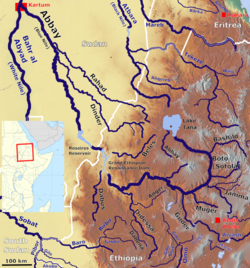TheJamma River(Amharic: ጃማ) is a river in centralEthiopiaand a tributary to theAbay(orBlue Nile). It drains parts of the Semien Shewa Zones of theAmharaandOromia Regions.The Upper Jamma flows through steep, deep canyons cut first through volcanic rock and then through theCretaceoussandstone and shaly sandstone, withJurassiclimestone at the bottom.[1]It has a drainage area of about 15,782 square kilometers in size.[2]Tributaries include theWanchet.
| Jamma River | |
|---|---|
 Map showing the Abbay basin, with the Jamma River (Bottom right) | |
 | |
| Location | |
| Country | Ethiopia |
| Physical characteristics | |
| Mouth | |
• location | Blue Nile |
• coordinates | 10°09′26″N38°20′28″E/ 10.1572°N 38.3412°E |
The earliest mention of this river is in theGadlaofTekle Haymanot,which was written in the fourteenth century.[3]One of the earliest European mentions is by the missionaryPedro Páez,who was the first European to see and describe the origin of the Abay.[1]According toJohann Ludwig Krapf,in the 1840s the Jamma defined the boundary betweenMarra BieteandMoret,two districts of the former province orSultanateofShewa.[4]
Notes
edit- ^ab"Local History in Ethiopia"Archived2011-05-28 at theWayback Machine(pdf) The Nordic Africa Institute website (accessed 29 January 2008)
- ^"Tana & Beles Integrated Water Resources Development: Project Appraisal Document (PAD), Vol.1",World Bank, 2 May 2008 (accessed 5 May 2009)
- ^G.W.B. Huntingford,The historical geography of Ethiopia from the first century AD to 1704,(Oxford University Press: 1989), p. 69
- ^Journals of the Rev. Messrs. Isenberg and Krapf, Missionaries of the Church Missionary Society, Detailing their proceedings in the kingdom of Shoa, and journeys in other parts of Abyssinia, in the years 1839, 1840, 1841 and 1842,(London, 1843), p. 290
External links
edit- Ethiopia Disaster Prevention and Preparedness Agency: Administrative atlas: Oromiya region
- Ethiopia Disaster Prevention and Preparedness Agency: Flood Vulnerable Areas as of August 24, 2006